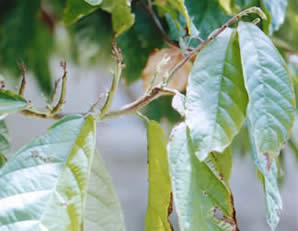Agronomic Practices | Planting Material | Technological Applications
Disease Management
Disease Management of Theobroma cacao by T.N. Sreenivasan
In Trinidad and Tobago two diseases of importance to cacao are Black Pod and Witches’ Broom. To manage these diseases to acceptable levels, all possible control measures should be used.
Jump to Witches' Broom disease management.
Black pod
This disease of cacao is present wherever cacao is grown. As its name suggests discolouring of pods is the main symptom. Excessive moisture in the field is the main factor which assists the disease to flourish. This can be caused by continual rainfall over several days, poor drainage, excessive shade and impeded air circulation in the field, all of which enhance the spread of the disease.
Preventing moisture retention in the field will help to reduce the incidence of black pod. Some simple measures are – increase air circulation, reduce shade, prune regularly, remove weeds frequently and ensure efficient drainage.
Keeping piles of pod husks in the field increases the population of the organisms responsible for black pod. To reduce this population avoid breaking pods in the field and piling up pod husks. Harvested pods should be taken out of the field. Regular spraying of husk piles with a fungicide also reduces pathogen’s growth.
Regularly removing infected pods from trees helps to reduce the incidence of black pod. Harvesting pods frequently prevents the spread of the disease in the field.
Growing disease resistant varieties of cacao minimises the crop losses due to black pod. The Ministry of Food Production, at its La Reunion Research Station, distributes Trinidad Selected Hybrids (TSH) plants which among other qualities are also disease resistant.
Chemical control measures are widely practised to reduce black pod disease in the field. Copper based fungicides are used globally. Several such fungicides are available and Extension Service’s recommendations and guidance should be followed to obtain satisfactory results.
The methods and frequency of applications of fungicide vary depending on the size of the plantation. Low volume motorised knapsack sprayers, as well as hand operated knapsack sprayers, are used for spraying fungicides. The frequency and type of applications also differ depending on the rainfall. Multiple applications (3 – 5) or single application of fungicide are recommended practices. Single application involves spraying fungicide only once in one season before the rains begin. However, the amount of fungicide applied is 3 – 5 times the quantity used for conventional application. The sprays are mainly deposited on the trunk and branches of trees to build up a fungicide reservoir on trees. During rainy periods, the rain water washes down the fungicide giving protection to the growing pods.

Witches’ broom
Witches’ broom disease of cacao causes malformation of shoots (broom), abnormality of cherelles (chirimoyas), flower distortion and pod infection, which destroys the beans. It is caused by a mushroom-like fungus and is present only in Western hemisphere cacao-growing countries. The pathogen does not produce infective spores continuously and spore production is absent during dry periods. The disease is not fatal, but if ignored it will destroy a plantation gradually. The most effective management of this disease is through sanitation methods.
Recommended practices to keep this disease in check are –
- Plant resistant cultivars
- Restrict the height of trees by pruning off basal and canopy chupons
- Remove brooms from trees before rains begin
- Remove diseased pods with their stalks
- Clean off affected parts of Infected flower cushions (flowers, brooms, chirimoyas)
- Remove infected parts thoroughly and every year
- Remove diseased parts (brooms, pods) before the period of pod set and growth to reduce the production of infective spores
- Remove infected material to reduce the production of spores, which in turn will gradually lessen disease incidence. It is essential to practice this continually
- Do not heap the removed diseased material in the field. Material should be scattered to allow contact with soil or covered with the leaf litter.
- Establish these sanitation procedures during March/April (in Trinidad and Tobago)
- Remove infected material again if the field is affected severely
Biological control methods using organisms antagonistic to the witches’ broom pathogen are used in some countries e.g. (Brazil) with limited success.
Chemical applications are also recommended, especially to lower pod infections
Grafting resistant clones to old susceptible trees is also recommended as a control measure against witches’ broom.
Strictly following sanitation practices from the early stages of the crop (3 years after planting) will prevent the gradual increase and establishment of the disease in fields.

















